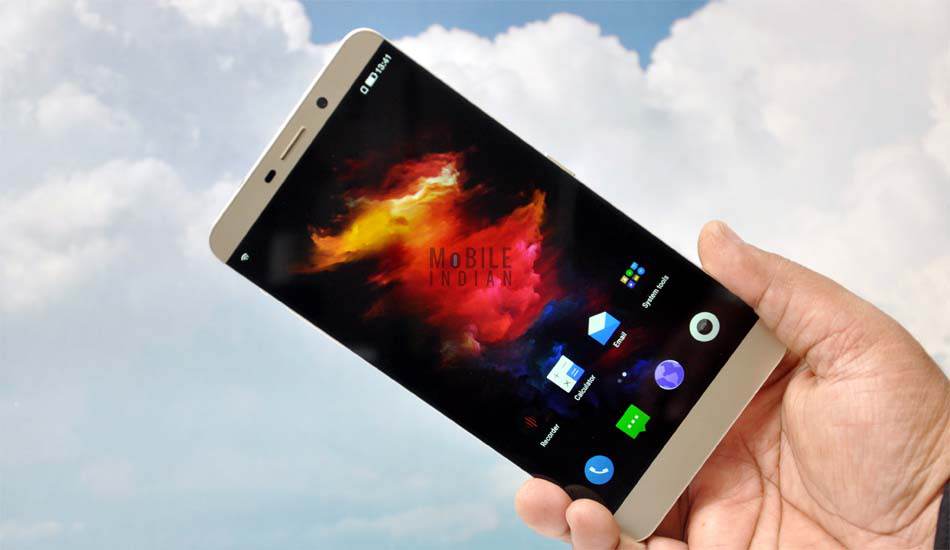LeEco had more than a month back launched three smartphones – Le Max, Le Max Sapphire and Le 1S. The Le 1S is priced at Rs 10,999, Le Max at Rs 32,999 while the Le Max Sapphire is priced at Rs 69,999. We have already reviewed Le 1S (Review, Gallery, Camera Test) and today we present to the review of Le Max.
Let’s first start with its specification. The Le Max has a 6.33-inch screen with 2560 x 1440 pixels (Quad HD) resolution that translates to 403 pixels per inch. It is powered by a Snapdragon 810 octa-core 64-bit CPU and an Adreno 430 GPU. It has 4GB of RAM and 64 GB built-in storage but it doesn’t support expandable storage. It is based on Android 5.0.2 Lollipop and has the LeEco’s EUI 5 user interface on top of it.
Le Max is a Dual-SIM smartphone (nano+micro). It has a 3,000 mAh battery, 21-megapixel rear-facing camera with dual-LED flash and a 4-megapixel front-facing camera. It has a dimension of 167.1mm height, 83.5mm width and 8.95mm thickness. The phone weighs 204 grams. It also has an infra-red port.
Inside the box of Le Max, one will find a charger, Type-C cable and a small but useful Micro USB to USB-C adapter. Besides, it has an SIM tray ejector and a plastic cover along with the device. The whole packaging has been neatly done.
What is in its favour
The first thing that goes in the favour of Le Max is its design. It has a unibody design and has an all-aluminium build. In the back panel, one will definitely notice its two Antenna lines that are evenly placed on both the top and bottom, a camera hump which looks like a plateau accompanied by dual tone LED flashlight, fingerprint scanner lust below the camera and a microphone.
When the display is in off mode, the front panel of Le Max gives a zero-bezel impression but it is not. The bezel below the display is quite wide and here you will see three capacitive buttons (multitasking, setting/notification, home/back). The speaker grill flanks the USB Port C on both the sides of the bottom panel. The power button is on the right panel while the volume rocker and a vibration toggle are on its left-hand side.
The second strong point of Le Max is its processing power. One can throw any task to Max, like gaming and multitasking, and it will not show any signs of lag. The phone doesn’t show any major sign of heating up inspite of having Qualcomm’s 64-bit Snapdragon 810 octa-core processor, which is quite notorious for its heating issue.
The third point in its favour is the camera. The pictures clicked in bright or natural light came out without any blemish but in low-light, colour reproduction was a bit on the lower side though the cameras managed to offer good detailing.
The fingerprint scanner and connectivity options were other highlights of Le Max. The Le Max has a customised user interface which has many elements of iOS. For instance, in Le Max, the top pull down panel shows notifications like messages, calls etc but to access toggles like Bluetooth, WiFi, location etc, you have to press the multitasking capacitive button, which is located below the display.
What in not in its favour?
The device is not meant for people with small palm size; It will be difficult for them to handle and carry it. And those who don’t watch videos or play games on mobile, its huge size becomes a burden than a boon.
Another problematic area is its battery back up. With one SIM, it gives a backup of about 10 to 12 hours but with two SIMs the backup drops to 6 – 8 hours which will be an issue. LeEco can address this issue by the way of an update and I believe it should be done at the earliest.
The second problematic area is its price. I am of the opinion that a price drop of around Rs 5,000 – Rs 7,000 can make it really attractive for a lot of potential customers, who are at this moment probably are ignoring the Le Max in favour of devices of recognised brands.
The third issue is more of an operational issue, The content ties up with Eros and Yupp Tv needs to be rolled out soon because that was one of the things that LeEco has stressed as the USP of the device during its launch.


